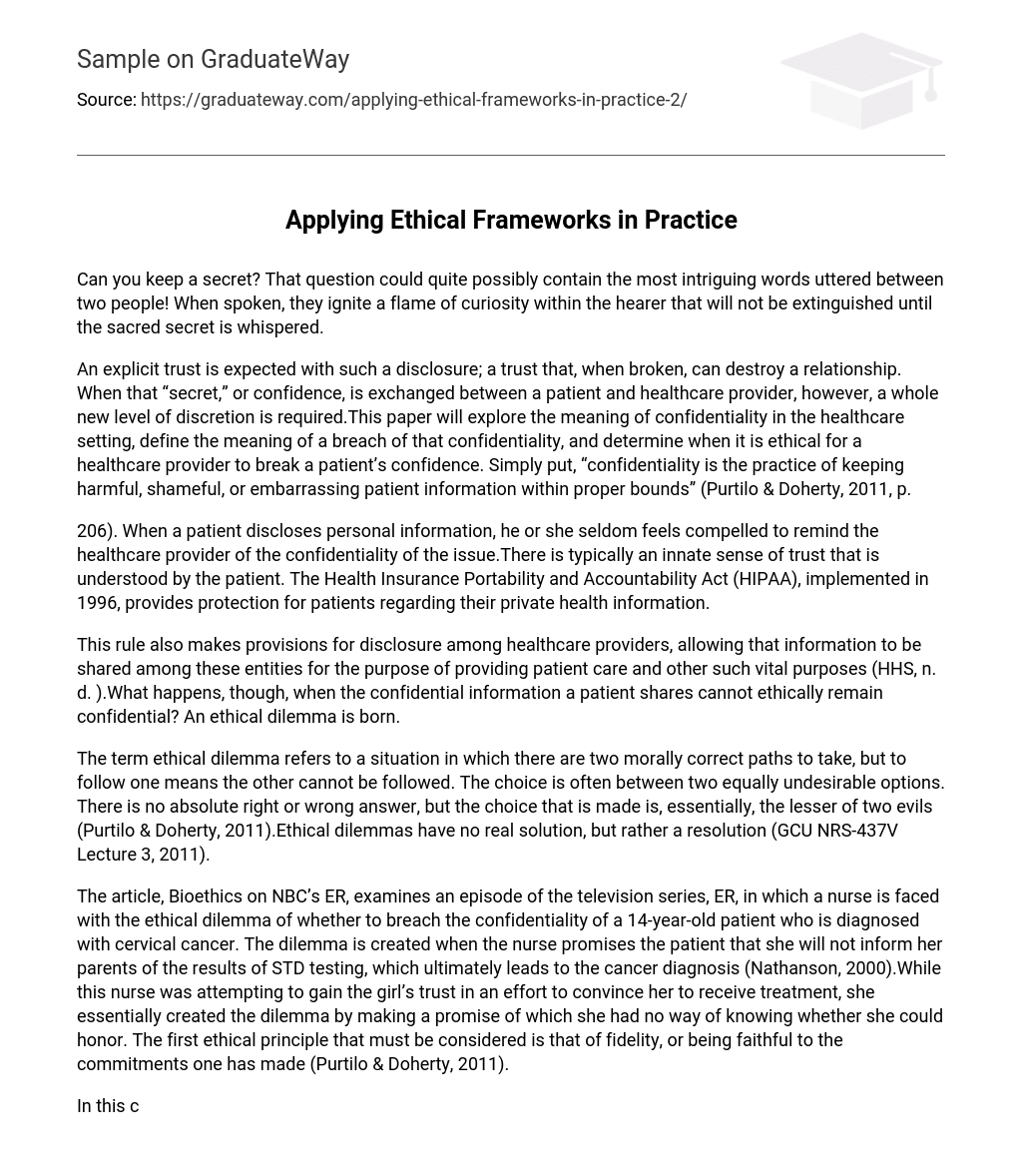Can you keep a secret? This question has the power to captivate two individuals and ignite curiosity until the secret is finally revealed.
When a patient confides in a healthcare provider, it requires a high level of trust. Breaking that trust can harm their relationship. In the healthcare setting, confidentiality takes on a whole new level of importance. This essay will explore what confidentiality means in healthcare, define what qualifies as a breach of confidentiality, and address the ethical considerations around healthcare providers breaking a patient’s confidence. In simple terms, confidentiality is about keeping sensitive patient information restricted to appropriate boundaries (Purtilo & Doherty, 2011, p.
Patients typically depend on healthcare providers to maintain the confidentiality of their personal information as expected. The Health Insurance Portability and Accountability Act (HIPAA), enacted in 1996, sets forth safeguards for safeguarding patients’ health information.
This rule allows healthcare providers to share patient information for the purpose of patient care and other essential services (HHS, n. d.). However, there are instances where preserving the confidentiality of shared patient information can pose an ethical dilemma.
When individuals are faced with an ethical dilemma, they must choose between two morally correct options. Unfortunately, selecting one option means the other cannot be pursued, and in most cases, neither option is desirable. Although there is no clear right or wrong answer in these situations, the chosen option is usually seen as the lesser of two evils (Purtilo & Doherty, 2011). Resolving ethical dilemmas does not involve finding definitive solutions but rather involves making decisions (GCU NRS-437V Lecture 3, 2011).
The episode “Bioethics on NBC’s ER” of the television series ER explores a nurse’s ethical dilemma. The nurse must decide whether to violate the privacy of a 14-year-old patient with cervical cancer. The nurse had promised the patient that she would not disclose the results of STD testing, which led to the cancer diagnosis. This promise was intended to build trust and encourage the patient to seek treatment. However, by making a promise without knowing if it could be kept, the nurse created an ethical dilemma. The first ethical principle at play is fidelity, or honoring commitments made.
In this case, the commitment is the nurse’s promise to not share test results with the patient’s parents. Notifying the parents would violate the nurse’s fidelity principle and could create trust issues with healthcare providers for the patient in the future. However, not disclosing the information could potentially be fatal if the patient does not receive treatment for cancer. The principle of veracity binds one to the truth (Perlite & Doherty, 2011).
It is the nurse’s responsibility to inform the patient of the diagnosis, and in doing so, she can assist the girl in comprehending the severity of the condition and the importance of receiving treatment. Although disclosing test results to parents would violate patient confidentiality, the nurse might be able to convince the patient to disclose this information voluntarily. If successful, this approach could strengthen the patient’s faith in her healthcare providers and nurture a sense of autonomy. The conflict in this scenario stems from opposing principles: autonomy, which enables patients to make their own treatment decisions, versus paternalism.
When the patient’s preferences clash with the professional’s judgment on what is most advantageous for the patient, paternalism becomes relevant (Purtilo & Doherty, 2011). Considering the patient’s status as a minor and her young age, paternalism is an appropriate principle to consider in this situation. By incorporating this principle, the nurse can act according to her own assessment of what is in the best interest of the young patient, potentially preserving her life. The utilitarian theory of ethics applies in this context.
The theory proposed by Purtilo & Doherty (2011) suggests that the best solution to a dilemma is the one that yields the most favorable outcomes. In this particular case involving a young girl, it would be beneficial for her to receive cancer treatment, even if it means breaking her trust. Consequently, informing her parents would be the most logical course of action. The application of the Ideal Observer Theory in this situation involves an ethics committee.
In 2002, the creation of a committee in acute care settings was mandated by President George Bush. This committee consists of members from various fields and serves as an impartial entity in resolving dilemmas like the one mentioned. The committee’s diverse backgrounds and expertise enable the development of well-rounded alternatives (GCU NRS-437V Lecture 3, 2011). Ultimately, the nurse’s primary responsibility is to the patient.
The American Nurses Association’s Code of Ethics emphasizes the importance of nurses upholding confidentiality. According to the Code, when deciding whether to disclose confidential information, the primary concern should be safeguarding the patient’s well-being, rights, and safety (American Nurses Association, 2001). If breaching confidentiality is shown to result in the most beneficial outcome for the patient, as depicted on television shows, it is not only allowed but also favored.





